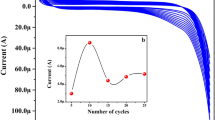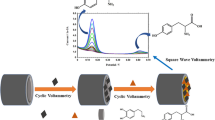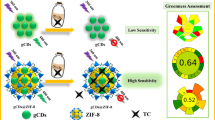Abstract
We have developed a biosensor for highly sensitive and selective determination of the endocrinic disruptor bisphenol A (BPA). It is based on glassy carbon electrode modified with calf thymus DNA and a composited prepared from single walled carbon nanotubes (SWNT) and Nafion. The interaction between BPA and DNA was studied by voltammetry. The binding constant was determined to be 3.55 × 103 M−1, and the binding site has a length of 4.3 base pairs. These electrochemical studies provide further information for a better understanding of the toxicity and carcinogenicity of BPA. Under optimal conditions, the biosensor displays a linear electrochemical response to BPA in the 10 nM to 20 μM concentration range, with a detection limit as low as 5.0 nM (at an S/N of 3). The method was successfully applied to the quantification of BPA in leachates from plastic baby bottles. Recoveries range from 94.0 % to 106.0 % which underpins the excellent performance of this SWNT-based DNA sensor.

A biosensor based on DNA and single walled carbon nanotubes modified glassy carbon electrode displays a linear electrochemical response to bisphenol A in the 10 nM to 20 μM concentration range, with a detection limit as low as 5.0 nM (at an S/N of 3).






Similar content being viewed by others
References
Staples CA, Dorn PB, Klecka GM, O’Block ST, Harris LR (1998) A review of the environmental fate, effects, and exposures of bisphenol A. Chemosphere 36:2149–2173
Biedermann-Berm S, Grob K (2009) Release of bisphenol A from polycarbonate baby bottles: water hardness as the most relevant factor. Eur Food Res Technol 228:679–684
Kovaaic P (2010) How safe is bisphenol A? Fundamentals of toxicity: metabolism, electron transfer and oxidative stress. Med Hypotheses 75:1–4
Bezaee M, Yamini Y, Shariati S, Esrafili A, Shamsipur M (2009) Dispersive liquid-liquid microextraction combined with high-performance liquid chromatography-UV detection as a very simple, rapid and sensitive method for the determination of bisphenol A in water samples. J Chromatorgr A 1216:1511–1514
García-Prieto A, Lunar ML, Rubio S, Pérez-Bendito D (2008) Determination of urinary bisphenol A by coacervative microextraction and liquid chromatography-fluorescence detection. Anal Chim Acta 630:19–27
Inoue K, Kato K, Yoshimura Y, Makino T, Nakazawa H (2000) Determination of bisphenol A in human serum by high-performance liquid chromatography with multi-electrode electrochemical detection. J Chromatogr B 749:17–23
Gómez MJ, Agüera A, Mezcua M, Hurtado J, Mocholí F, Fernández-Alba AR (2007) Simultaneous analysis of neutral and acidic pharmaceuticals as well as related compounds by gas chromatography-tandem mass spectrometry in wastewater. Talanta 73:314–320
Kuramitz H, Nakata Y, Kwwasaki MS, Tanaka S (2001) Electrochemical oxidation of bisphenol A: Application to the removal of bishphenol A using a crbon fiber electrode. Chemosphere 45:37–43
Xue F, Wu JJ, Chu HQ, Mei ZL, Ye YK, Liu J, Zhang R, Peng CF, Zheng L, Chen W (2013) Electrochemical aptasensor for the determination of bisphenol A in drinking water. Microchim Acta 180:109–115
Gao Y, Cao Y, Yang DG, Luo XJ, Tang YM, Li HM (2012) Sensitivity and selectivity determination of bisphenol A using SWCNT-CD conjugate modified glassy carbon electrode. J Hazard Mater 199–200:111–118
Portaccio M, Tuoro DD, Arduini F, Lepore M, Mita DG, Diano N, Mita L, Moscone D (2010) A thionine-modified carbon paste amperometric biosensor for catechol and bisphenol A determination. Biosens Bioelectron 25:2003–2008
Wang F, Yang J, Wu K (2009) Mesoporous silica-based electrochemical sensor for sensitive determination of environmental hormone bisphenol A. Anal Chim Acta 638:23–28
Yin H, Zhou Y, Ai S (2009) Preparation and characteristic of cobalt phthalocyanine modified carbon paste electrode for bisphenol A detection. J Electroanal Chem 626:80–88
Li Q, Li H, Du GF, Xu ZH (2010) Electrochemical detection of bisphenol A mediated by [Ru(bpy)3]2+ on an ITO Electrode. J Hazard Mater 180:703–709
Niu XL, Yang W, Wang GY, Ren J, Guo H, Gao JZ (2013) A novel electrochemical sensor of bisphenol A based on stacked graphene nanofibers/gold nanoparticles composite modified glassy carbon electrode. Electrochimica Acta 98:167–175
Li JH, Kuang DZ, Feng YL, Zhang FX, Liu MQ (2011) Voltammetric determination of bisphenol A in food package by a glassy carbon electrode modified with carboxylated multi-walled carbon nanotubes. Microchim Acta 172:379–386
Poorahong S, Thammakhet C, Thavarungkul P, Limbut W, Numnuam A, Kanatharana P (2012) Amperometric sensor for detection of bisphenol A using a pencil graphite electrode modified with polyaniline nanorods and multiwalled carbon nanotubes. Microchim Acta 176:91–99
Zheng ZX, Du YL, Wang ZH, Feng QL, Wang CM (2013) Pt/graphene-CNTs nanocomposite based electrochemical sensors for the determination of endocrine disruptor bisphenol A in thermal printing papers. Analyst 138:693–698
Luo LQ, Liu JY, Wang ZX, Yang XR, Dong SJ, Wang EK (2001) Fabrication of layer-by-layer deposited multilayer films containing DNA and its interaction with methyl green. Biophys Chem 94:11–22
Pérez-López B, Merkoçi A (2012) Carbon nanotubes and graphene in analytical sciences. Microchim Acta 179:1–16
Jagota A, Diner BA, Boussaad S, Zheng M (2005) Carbon nanotube-biomolecule interactions: Applications in carbon nanotubes separation and biosensing. Nanosci Nanotechnol 10:253–271
Wang YW, Liu H, Wang F, Gao YM (2012) Electrochemical oxidation behavior of methotrexate at DNA/SWCNT/Nafion composite film-modified glassy carbon electrode. J Solid State Electrochem 16:3227–3235
Vega D, Agüí L, Cortés G, Yáñez-Sedeño P, Pingarrón JM (2007) Electrochemical detection of phenolic estrogenic compounds at carbong nanotube-modified electrodes. Talanta 71:1031–1038
Zheng YQ, Yang CZ, Pu WH, Zhang JD (2009) Carbon nanotube-based DNA biosensor for monitoring phenolic pollutants. Microchim Acta 166:21–26
Wang YL, Liu L, Li MG, Xu SD, Gao F (2011) Multifunctional carbon nanotubes for direct electrochemistry of glucose bioassay. Biosens Bioelectron 30:107–111
Wang MZ, Zheng JB (2012) Direct electrochemistry and electrocatalysis of hemoglobin immobilized on the functionalized grapheme-carbon nanotube composite film. J Electrochem Soc 159:F150–F156
Reichmann ME, Rice SA, Thomas CA, Doty P (1954) A further examination of the molecular weight and size of desoxypentose nucleic acid. J Am Chem Soc 76:3047–3053
Ballesteros-Gómez A, Rubio S, Pérez-Bendito D (2009) Analytical methods for the determination of bisphenol A in food. J Chromatogr A 1216:449–469
Laviron E (1979) General expression of the linear potential sweep voltammogram in the case of diffusionless electrochemical systems. J Electroanal Chem 101:19–28
Ngundi MM, Sadik OA, Yamaguchi T, Suye S (2003) First comparative reaction mechanisms of β-estradiol and selected environmental hormones in a redox environment. Elecrochem Commun 5:61–67
Bard AJ, Faulkner LR (1980) Electrochemical methods: Fundamentals and Applications. Wiley, New York, chapter 6
Carter MT, Rodriguez M, Bard AJ (1989) Votammetric studies of the interaction of metal chelates with DNA. 2. Tris-Chelated complexes of cobalt (III) and iron (II) with 1, 10-phenanthroline and 2, 2′-bipyridine. J Am Chem Soc 111:8901–8911
Acknowledgments
The authors gratefully acknowledge financial support from the Key project of Shenzhen Polytechnic (No.2210 K3070014) and “Qianbaishi Candidate” fund for Higher Education of Guangdong Province.
Author information
Authors and Affiliations
Corresponding author
Electronic supplementary materials
Below is the link to the electronic supplementary material.
ESM 1
(DOC 43 kb)
Rights and permissions
About this article
Cite this article
Jiang, X., Ding, W., Luan, C. et al. Biosensor for bisphenol A leaching from baby bottles using a glassy carbon electrode modified with DNA and single walled carbon nanotubes. Microchim Acta 180, 1021–1028 (2013). https://doi.org/10.1007/s00604-013-1025-4
Received:
Accepted:
Published:
Issue Date:
DOI: https://doi.org/10.1007/s00604-013-1025-4




